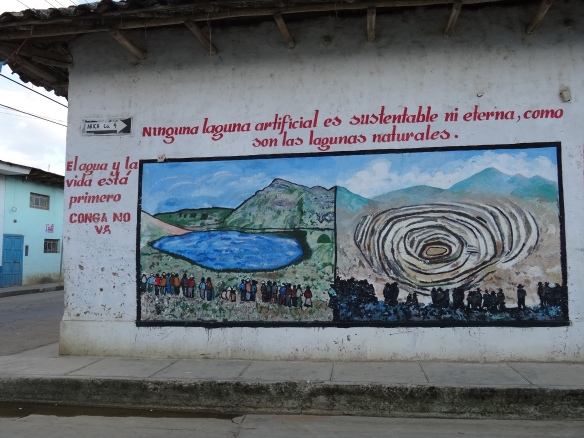I stared at the large sunken stone-lined bath: you could fit a whole rugby team in it, maybe even both sides. Empty now but with the lifting of two wooden gates hot mineral rich water from deep underground would race through stone cut channels and fill it to the brim. A bath fit for a king, as indeed it was on the 16th November 1532 when the Incan Emperor Atahualpa was soaking away the cares from administering to an empire that extended for over two thousand miles either side of the massive spine of the Andes in South America. Whilst relaxing in the hot volcanic water he was made aware that the group of strangers who had landed on the Pacific coast a few weeks previously were now just a few miles away in the town of Cajamarca. He was curious to meet these bearded men who rode on giant animals and knowing that they were only 168 in number their presence in his kingdom caused him no concern whatsoever.
We left the Royal Bath and relocating to a modern complex were ushered into a white-tiled room with a smaller version of the sunken bath across the way. The steaming water poured out of a 6-inch pipe and soon we were both floating side by side. Lying in the water I reflected on that day early in the 16th-century when South America’s history was about to take a change of enormous consequence. It has always struck me that throughout the course of history the ‘axis of evil’ has systematically swung through most of the major edifices to power and sovereignty in the world and in 1493 it went directly through the Vatican Palace and the body of Pope Alexander VI, a Spaniard who had bribed his way into the papacy. In an act of a totally diabolical nature Pope Alexander had issued a papal bull (an apt title if ever there was) that had eventually resulted in the Spanish Crown being granted all lands 370-leagues west of the Cape Verde Islands. With one single pronouncement from this pope the Spanish crown had received a divine grant that bequeathed huge regions of land and people as yet to be discovered. The inhabitants of these new lands, according to the proclamation, were already subjects of the Spanish King, all that remained was that they be located and informed of this fact and that they now owed the Spanish crown their ‘tributes and rights’. The corollary of this mindset was that the people of the New World had no right to resist the pope’s edict which was clearly also God’s will. A refusal to do so would be to go against God’s command and by definition make one a rebel and ‘unlawful combatant’.
I imagined Atahualpa ascending the stone steps from his bath and being dressed prior to proceeding in state with several thousand soldiers and attendants to the town square in Cajamarca where the Spanish were waiting with a mixture of trepidation and expectation. It is often assumed that the Spanish Conquistadors were professional soldiers sent and financed by the King. In fact most were common tradesmen, cobblers, tailors, blacksmiths and barbers all hoping to find a large population of natives in order to strip them of their wealth and live off their labour. Tragically, as it turned out, Atahualpa’s amusement at how like children Pizarro and his men behaved when they saw his magnificent gold and silver tableware was misplaced. By wrongly assuming that by filling a large room full of precious metals the bearded foreigners would depart never to be seen again he changed the course of South American history.

Whenever new land and people were discovered in the New World a protocol had developed that saw a document known as a ‘requerimiento’ (requirement) being read – usually in Spanish – by the conquistadors to the native population. This document, being both a justification and an ultimatum, explained to the newly discovered people that since the Christian God had created the world, and granted the divine right to rule this world to his emissary on earth, they now owed allegiance to his will. If, on hearing this information, the natives disobeyed then all necessary measures would be used to force them to submit to the dictates of God or else to eliminate them from the face of the earth. This ‘reading of the rights’ was little other than permission, if necessary, to enact extreme violence sanctioned by God.
The following morning we were back in hot water but this time it was a circular outdoor swimming pool filled with the same thermal water as the baths. It was a mostly male affair, short powerful descendants of both Atahualpa and the Spanish conquistadors and seemed to be less about swimming than various forms of aquatic exercise: one-armed backstrokes; convoluted butterfly’s; front crawls with no leg action. One short diameter seemed enough and then the swimmers would wait their turn to re-cross the pool. I waited for a space and then did a slow crawl to the other side from where I could see a wall painted with the slogan ‘Oro No, Agua Si’ – gold no, water yes. There is still gold in the hills around Cajamarca but not of the sort that sees prospectors holding up huge gleaming nuggets. This is the sort that requires toxic chemicals and huge quantities of water to prise it from the rock in which it is incarcerated. So, once again, Peru’s indigenous people – the gold being in rural areas – are threatened by powerful foreign bodies after the yellow metal. The ‘axis of evil’ spins on as always and now runs through corporate boardrooms as venomously as it has, and still does, religious and political institutions.

Water or gold, what would you value more?
